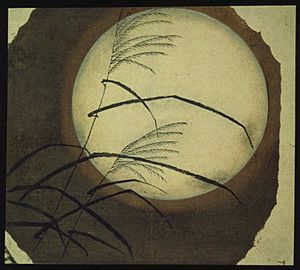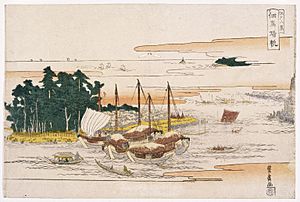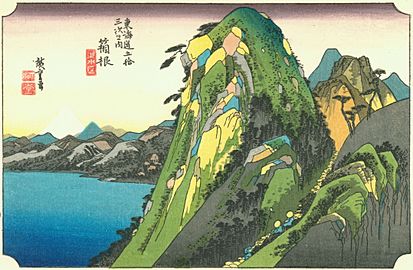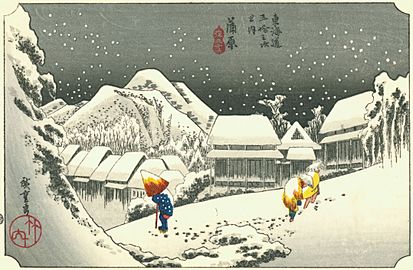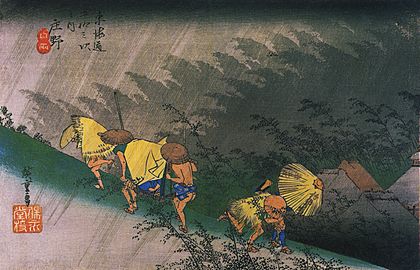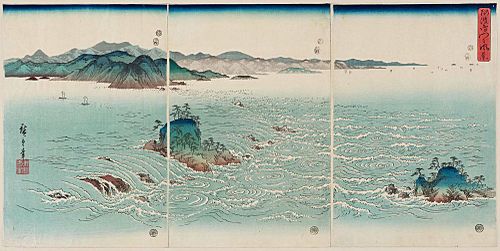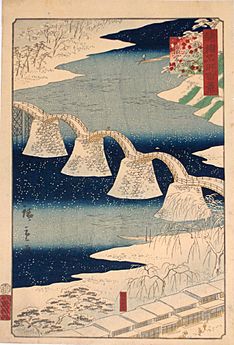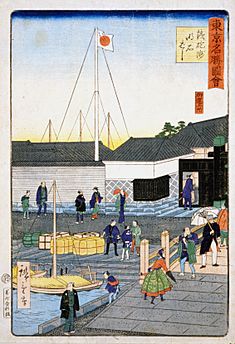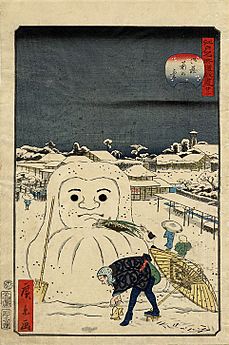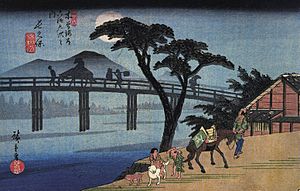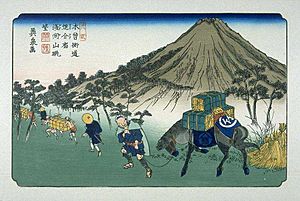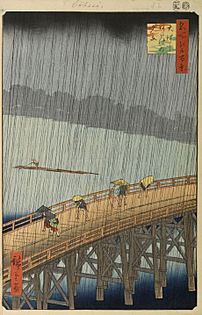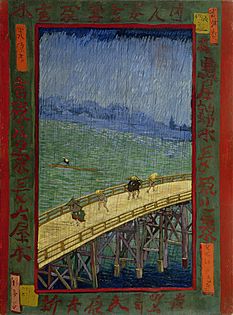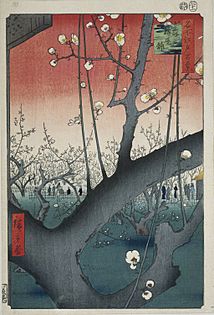Hiroshige facts for kids
Quick facts for kids
Hiroshige
|
|
|---|---|
| 広重 | |
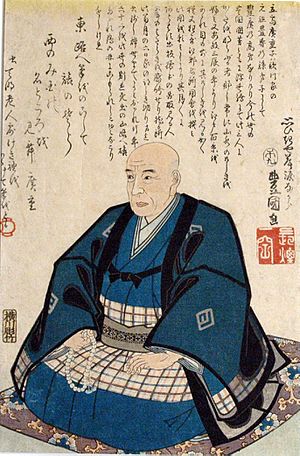
Memorial portrait of Hiroshige by Kunisada
|
|
| Born |
Andō Tokutarō
1797 |
| Died | 12 October 1858 (aged 60–61) Edo, Japan
|
| Nationality | Japanese |
| Education | Toyohiro |
| Known for |
|
|
Notable work
|
|
| Movement | Utagawa school |
Utagawa Hiroshige (born Andō Tokutarō; 1797 – October 12, 1858) was a famous Japanese artist. He is known as the last great master of ukiyo-e, a type of Japanese art. Ukiyo-e means "pictures of the floating world." These artworks showed everyday life, beautiful women, and popular actors.
Hiroshige is best known for his amazing landscape prints. His most famous series are The Fifty-three Stations of the Tōkaidō and One Hundred Famous Views of Edo. Unlike many ukiyo-e artists who focused on people, Hiroshige loved to draw nature and travel scenes. His art was very poetic and used colors in a special way. He often used a technique called bokashi, which creates soft color changes.
Hiroshige's work had a big impact on Western art. European artists like Monet and Vincent van Gogh collected and studied his prints. Van Gogh even painted copies of two of Hiroshige's prints: Plum Park in Kameido and Sudden Shower over Shin-Ōhashi bridge and Atake.
Contents
Early Life and Art Training
Hiroshige was born in 1797 in Edo (which is now Tokyo). His family had a samurai background. His father was a fire warden for their area, a job Hiroshige later took over.
When Hiroshige was young, he had a few different names. His mother and father both died in 1809 when he was only twelve. After his father's death, Hiroshige became the fire warden. This job gave him a lot of free time.
Around age fourteen, Hiroshige started painting. He wanted to learn from a famous artist named Toyokuni. But Toyokuni had too many students. So, Hiroshige was introduced to Toyohiro, another artist from the same Utagawa school. By 1812, Hiroshige was allowed to sign his artworks with his art name, Hiroshige. He also learned other painting styles, including some Western art techniques.
At first, Hiroshige created book illustrations and prints of beautiful women and kabuki actors. This was typical of the Utagawa style. In 1823, he gave his fire warden job to his son.
Famous Landscapes and Nature Prints
It wasn't until 1829–1830 that Hiroshige started making the landscape prints he is famous for. He also began creating many prints of birds and flowers. Around 1831, his series Ten Famous Places in the Eastern Capital came out. This series seemed to be influenced by Hokusai, another famous artist, who had recently published his popular landscape series Thirty-six Views of Mount Fuji.
In 1832, Hiroshige got a chance to travel along the Tōkaidō route. This road connected the two main cities of Japan, Edo and Kyoto. He sketched the scenery he saw during his trip. When he returned to Edo, he used these sketches to create his very famous series, The Fifty-three Stations of the Tōkaidō. This series includes some of his best-known prints.
- Selections from ''The Fifty-three Stations of the Tōkaidō''
Because The Fifty-three Stations of the Tōkaidō was so successful, Hiroshige made more travel series. These included Illustrated Places of Naniwa (1834) and Famous Places of Kyoto (1835). Since he had never traveled west of Kyoto, he based his illustrations of places like Naniwa (modern Osaka) on pictures from books.
Hiroshige's first wife helped him pay for his trips. She even sold some of her clothes to help him. She died in 1838, and Hiroshige later remarried.
Between 1835 and 1842, Hiroshige worked on The Sixty-nine Stations of the Kiso Kaidō with another artist, Keisai Eisen. Hiroshige created 46 of the 70 prints in this series. In the last ten years of his life, starting around 1848, Hiroshige made 118 prints for his series One Hundred Famous Views of Edo.
- Selections from ''One Hundred Famous Views of Edo'' and ''Thirty-six Views of Mount Fuji''
Hiroshige's Students
Hiroshige had several students. One of them, Chinpei Suzuki, married Hiroshige's daughter, Otatsu. He was given the art name "Shigenobu." After Hiroshige died in 1858, Shigenobu took on the name "Hiroshige" and is now known as Hiroshige II.
Later, Otatsu separated from Hiroshige II and married another student, Shigemasa. Shigemasa then took the name "Hiroshige" and is known as Hiroshige III. Both Hiroshige II and Hiroshige III continued to make prints in a style similar to their teacher, but they did not become as famous as Hiroshige I. Other students included Utagawa Shigemaru, Utagawa Shigekiyo, and Utagawa Hirokage.
- Followers of Hiroshige
Later Life and Legacy
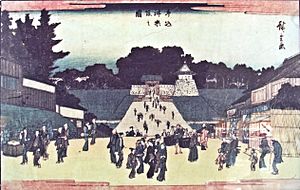
In his later years, Hiroshige still made thousands of prints. People loved his work, but he was not very rich. He was paid less than other popular artists. Even so, he created some of his best art during this time, like his famous One Hundred Famous Views of Edo.
In 1856, Hiroshige became a Buddhist monk. This was the same year he started his One Hundred Famous Views of Edo series. He died at age 62 in 1858 during a big cholera outbreak in Edo. It's not known if the disease caused his death. He was buried in a Zen Buddhist temple in Asakusa.
Just before he died, he wrote a farewell poem:
I leave my brush in the East,
And set forth on my journey.
I shall see the famous places in the Western Land.
The "Western Land" in his poem refers to a part of Japan, but it also means a paradise in Buddhist beliefs.
Even though he was very productive and popular, Hiroshige was not wealthy. His will even included instructions for paying his debts.
Hiroshige's Artworks
Hiroshige created over 8,000 artworks in his lifetime. At first, he focused on common ukiyo-e themes like women (bijin-ga) and actors (yakusha-e). But after his teacher Toyohiro died, Hiroshige changed his focus. In 1831, he released his landscape series Famous Views of the Eastern Capital, which was praised for its design and colors.
His success was truly set with The Fifty-three Stations of the Tōkaidō (1833–1834). These designs came from his actual travels along the 490 km (300 mi) Tōkaidō road. He included details about the date, location, and stories from his fellow travelers. This series was incredibly popular. He even reissued it in different versions. Hiroshige went on to create more than 2,000 different prints of Edo and post stations along the Tōkaidō. He also made series like The Sixty-nine Stations of the Kisokaidō (1834–1842) and his own Thirty-six Views of Mount Fuji (1852–1858). Landscapes made up the largest part of his estimated 5,000 designs.
Hiroshige became the leading artist for landscape prints. His works were often intimate and smaller in scale compared to older Chinese landscape paintings. His travel prints usually showed travelers on famous routes, enjoying the special sights at different stops. He showed them traveling in rain, snow, and during all seasons.
In 1856, he worked with a publisher to create a series of special, high-quality prints. These prints used advanced techniques like true color gradation, adding mica for a shimmering effect, and embossing. Hiroshige also helped make vertical landscape prints popular with his series Famous Views of the Sixty-odd Provinces. His One Hundred Famous Views of Edo (1856–1859) was hugely popular. He created over 100 prints for this set, and two more were added by Hiroshige II after his death.
Influence on Art
Hiroshige was part of the Utagawa school, a group of many artists who were leaders in 19th-century woodblock prints. This school was known for its actor and historical prints, but its artists were skilled in all popular art styles.
During Hiroshige's time, the art print industry was growing fast. More and more people wanted to buy prints. Before this, most print series were small, with only ten or twelve designs. But to meet the demand, artists started making much larger series. You can see this trend in Hiroshige's work, like The Sixty-nine Stations of the Kisokaidō and One Hundred Famous Views of Edo.
Hiroshige is known for his unique style. He often used unusual viewpoints, hints of different seasons, and striking colors. He worked a lot on meisho-e (pictures of famous places). During the Edo period, travel was becoming popular, and people were very interested in seeing new places. Travel guides were common, and towns grew along routes like the Tōkaidō. Hiroshige used his own travels and stories from others to inspire his landscapes. For example, in The Fifty-three Stations on the Tōkaidō (1833), he illustrated funny stories from a popular travel comedy book.
Hiroshige's series The Fifty-three Stations of the Tōkaidō (1833–1834) and One Hundred Famous Views of Edo (1856–1858) had a great influence on French Impressionist artists like Monet. Vincent van Gogh copied two of the One Hundred Famous Views of Edo prints that he owned. Hiroshige's style also influenced a 20th-century Russian art movement called the Mir iskusstva. Artists like Ivan Bilibin and Mstislav Dobuzhinsky were inspired by him. Dobuzhinsky said he liked to choose "unusual" viewpoints, and Hiroshige was a constant example for him. Cézanne and Whistler were also influenced by Hiroshige. In 1883, Louise Gonse, a famous art director, called Hiroshige the greatest landscape painter of the 19th century.
- Van Gogh copies of Hiroshige's prints
-
Bridge in the rain (after Hiroshige) by Vincent van Gogh, 1887.
-
Flowering Plum Tree (after Hiroshige) (1887) by Vincent van Gogh.
Images for kids
See also
 In Spanish: Utagawa Hiroshige para niños
In Spanish: Utagawa Hiroshige para niños
- List of Utagawa school members
- Category:Print series by Hiroshige


